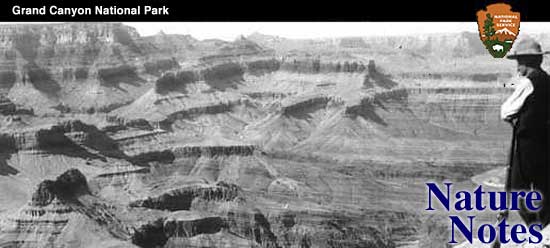

|
By Edwin D. McKee, Park Naturalist. ON the northeast side of the Santa Catalina Mountains near Tucson, Arizona, is a narrow gorge which has been appropriately named Peppersauce Canyon. This name was suggested by the brightly speckled rock which forms much of its lower walls - a type of conglomerate or pudding stone consisting of many rounded pebbles, both large and small, of red, black, yellow, white and various other colors. The conglomerate of Peppersauce Canyon is known as the Barnes, and is of Algonkian age. It is exposed in many of the mountain ranges of south central Arizona and is always easily recognizable by the shape and colors of its pebbles. These are generally six inches or less in diameter and smooth. They are not globular but flattened ellipsoids or round-edged discs, representing only very durable materials, including much white quartz, hard vitreous quartzite and vermilion red jasper. Dr. F. L. Ransome1 who has given much consideration to the nature of the pebbles of the Barnes conglomerate, concluded that they probably "represent stream action rather than littoral or marine action". He further stated that the formations which supplied the quartzite material are in the Sierra Ancha and Mazatzal Ranges of central Arizona, where older pre-Cambrian sediments occur. The presence of a peculiar type of vermilion jaspers in both places makes the validity of this correlation especially likely.
In the Shinumo quartzite found in the lower part of Grand Canyon a base that has the appearance of being nearly parallel to that of the Barnes conglomerate has recently been noted by the writer. This local formation which in numerous places is actually a friable sandstone, also contains many scattered pebbles, and at the bottom of the second or G member (about 70 feet above the formation base*) there is a definite conglomerate layer. The pebbles in this formation are composed of white quartz, Quartzite of various colors and some vermilion jasper. They are well rounded, and range in size up to four inches or more.
To the pebbles of quartz and quartzite in the Shinumo formation no particular importance can be attached. From the jaspers, however, representing a very distinctive mineral of definitely local distribution in the region, immediately comes the suggestion of a relationship to the region of central Arizona. While it is unwarranted to contend that this mineral alone can establish the source of the Shinumo sediments as being the same as that of the Barnes conglomerate, nevertheless it appears to definitely point toward the Sierra Ancha - Mazatzal Mountains as the place of origin in both cases as the jaspers may well prove to be important in ultimately solving this problem. | ||||||
| <<< Previous | > Cover < |
vol8-4e.htm
14-Oct-2011